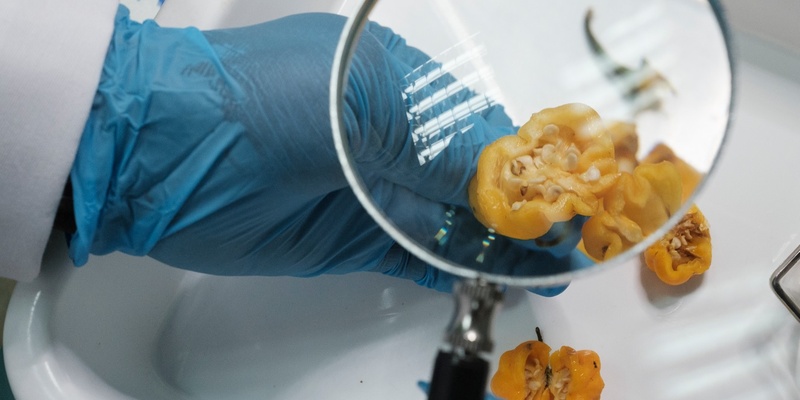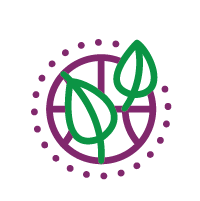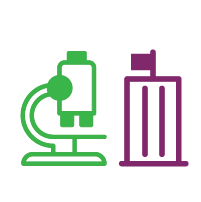What is a Phytosanitary Capacity Evaluation (PCE)?
The PCE is a collaborative process that helps countries evaluate their phytosanitary capabilities. National stakeholders, including the national plant protection organization (NPPO) staff, reach a consensus on the main phytosanitary gaps at the system, organizational, and technical levels. Under a structured framework, the PCE process helps identify how to address these critical gaps based on strategic planning and logical framework methodologies.
The PCE:
- Is a self-evaluation process driven by the NPPOs, giving them flexibility and control. Usually, it involves internationally trained facilitators who serve as navigators and guide the NPPOs in conducting a thorough assessment. However, the country may decide to conduct the assessment independently;
- Is supported by an online system comprising 13 modules designed in a questionnaire-style format to document the evaluation process systematically. NPPOs can select modules based on their current priorities and needs;
- Once the gaps are identified, the NPPO can create a sovereign plan to address and rectify these issues by applying strategic planning tools such as cause and effects analysis, SWOT analysis, logical framework, and the final output, a phytosanitary capacity development strategy which is validated by stakeholders.
To find out more about the PCE process and how to start one in your country, read the next steps below or contact Sarah Brunel, IPPC Implementation Facilitation Lead, at
[email protected]
PCEs in practice: examples and case studies
 Benefits
Benefits
 Who drives the PCE
Who drives the PCE
The process is driven by staff of the NPPO but should involve non-NPPO representatives from appropriate government agencies, research institutes, universities, agro-industries or import/export associations, etc.
The presence of an IPPC-certified PCE Facilitator streamlines the process while ensuring coordination and neutrality. Furthermore, the Facilitator's participation in the workshops enables participants to get a clearer understanding of the questions, Result-Based Management tools and suggestions on the next steps to take. Finally, the Facilitator supports the NPPO staff and private stakeholders in navigating through the PCE platform and briefs the participants in a teaching/training methodology prior to starting the process.
"PCE Facilitators guide discussions towards productive conclusions while refraining from expressing personal opinions, ensuring NPPOs and stakeholders take full ownership of the process. Facilitators also contribute to preserving the quality and integrity of the evaluation methodology by explaining and teaching the methodology and overseeing procedural aspects of workshops. It's important to note that facilitators enhance the objectivity of the evaluation practice".
 What does the PCE consist of?
What does the PCE consist of?
The goal of the process is to reach a consensus and develop a structured plan involving the country's stakeholders that addresses weaknesses and enhances the country's capacity in plant health. The PCE process will end in a National Phytosanitary Capacity Development Strategy and new or revised legislation/regulation.
To develop a National Phytosanitary Capacity Development Strategy, the process involves three PCE missions and various stakeholders who work together to identify gaps using a structured questionnaire format during the first mission. During the second PCE mission, strategic planning tools are used to develop a tailored plan for each module. The third mission involves validating the PCE findings, including activities and estimated costs, and following up on the implementation of the strategy and resource mobilization.
When the country selects to work on a new or revised legislation/regulation (Module 2), the process begins with a thorough Situation Analysis to assess the current legal framework's strengths and weaknesses during a first legal mission. As decided by the NPPO, drafting and consultation follow, involving stakeholders' input and the creation of a draft of new or revised legislation/regulation that addresses identified gaps. This draft is then reviewed and validated, ensuring legal soundness and international alignment. Finally, the Follow-up phase focuses on adopting and implementing the new or revised legislation/regulation.
 How is the PCE process applied
How is the PCE process applied
The PCE tool is available to any country upon making an official request to the IPPC Secretariat. Once contact has been made, a facilitator has been chosen and a PCE team is in place:
1. First PCE mission: situation analysis
The first PCE mission is held in the country and lasts about one week. It identifies and invites available members of the PCE team and relevant stakeholders. The mission starts with a briefing with the PCE team, followed by an official opening which may be attended by ministers.
A consensus workshop is then held with all relevant stakeholders to fill in the selected PCE Modules online. For each module, a maximum of five weaknesses are identified. The first PCE mission might also include technical visits to the airports, ports, border points, diagnostic laboratories, production sites, etc. A brief about the mission is prepared and sent to the FAO permanent representative, the highest authorities in the country and any stakeholders the PCE team considers relevant. A report is prepared after each mission and submitted to the IPPC Secretariat, indicating results to date and next steps.
2. Second PCE mission: strategic planning
The second PCE mission brings together the PCE team and all relevant stakeholders to prepare a problem tree, do a SWOT analysis and develop a logical framework to address the weaknesses that were identified. They then begin drafting a national phytosanitary capacity development strategy. A workshop can be organized to discuss the revised phytosanitary legislation or regulations with all stakeholders.
Field visits may be organized, and interviews are conducted with selected stakeholders.
3. Third PCE mission: validation
During the third and last PCE mission, all stakeholders validate the national phytosanitary capacity development strategy, which may include a draft legislation/regulations. They officially present them to the FAO country office, high-level national authorities and donors.
At this stage, the PCE team and stakeholders have taken full ownership of the outputs of the PCE and of the process itself. They are fully empowered to present and defend their phytosanitary legislation, regulations and strategy.
 What are the modules about
What are the modules about
The PCE modules cover the System Level, which assesses the overarching phytosanitary framework and environment within a country; the Organization Level, which assesses the structures, processes, and resources of the NPPO; and the Core Activities, which assesses the specific phytosanitary functions and capabilities that are crucial for safeguarding plant health.
The number of modules is chosen by national stakeholders, and it reflects and depends on the country's needs. A minimum of 5 modules is recommended, excluding module 1 – country profile – being mandatory.
 |
System Level
1: Country profile
2: National phytosanitary legislation
3: Environmental forces assessment |
 |
Organization Level
4: NPPOs mission and strategy
5: NPPOs structure and processes
6: NPPOs resources |
 |
Core Activities
7: Pest diagnostic capacity
8: NPPO pest surveillance and pest reporting capacity
9: Pest eradication capacity
10: Phytosanitary import regulatory system
11: Pest risk analysis
12: Pest free areas, places and sites, low pest prevalence areas
13: Export certification, re-export, transit
|
 How long does it last
How long does it last
The PCE is designed to be implemented at a pace defined by the country and generally lasts 6 months to 1 year. The IPPC Secretariat recommends that a complete PCE be applied every 3-4 years. It can be applied as a whole, or in parts, and as frequently as needed.
 Where has it been applied
Where has it been applied
The PCE has been applied across 4 continents, in over 120 countries since 1997 + map already existing to which we should add: Zimbabwe, Egypt and Uganda.
 How is it financed
How is it financed
The IPPC Secretariat has dedicated considerable efforts to developing the PCE and applying it in dozens of countries. A full-fledged PCE requires an average of USD 80 000 (including reviewing and drafting the primary phytosanitary legislation).
The IPPC Secretariat does not fund the PCE but works in close collaboration with donors to provide the support for applying a PCE when requested. Countries need to identify internal or donor-funded resources. Some contracting parties are able to finance the process unilaterally, e.g. from their national budget. In other situations, donors may sponsor the application of the PCE.
In all cases, countries should allocate some resources for planning, identifying stakeholders and organizing workshops to support the PCE process until completion.
In the majority of cases, the PCE has been applied through FAO Technical Cooperation Programme (TCP) projects. The completion of the PCE is often seen as a requirement from donors - such as the Standard and Trade Development Facility (STDF) - for granting project funds.
The cost for undertaking a PCE with the full IPPC secretariat support varies from $ 60,000 to $90,000, depending on whether the phytosanitary legislation is revised. This cost includes meetings costs in the country, recruitment of a PCE facilitator and lawyers, and travels costs to participate in the PCE missions
 Why are the outputs confidential
Why are the outputs confidential
The PCE modules and outputs are confidential for the following reasons
- The PCE process involves strategic thinking at the policy, technical and managerial levels. It also requires a deep understanding of plant health, stakeholders management, the operations of a phytosanitary system, the IPPC text and the international phytosanitary framework, etc. If PCE modules were freely accessible, they might be applied without the proper knowledge and facilitation and not be properly used.
- PCE modules collect comprehensive data about national phytosanitary systems that might be economically, politically and technically sensitive and countries might not wish these to be publicly released.
- Many years of experience shows that NPPOs ask for confidentiality regarding the PCE modules because of possible actions from trading partners.
Therefore, the IPPC does not share PCE results publicly unless a country wishes to use or present their PCE results to an external audience.
 أنا مهتم ببدء PCE في بلدي. ما هي الخطوات التالية؟
أنا مهتم ببدء PCE في بلدي. ما هي الخطوات التالية؟
لإجراء PCE يجب إرسال خطاب طلب رسمي من قبل مسؤول رفيع المستوى (وزير الزراعة أو رئيس المنظمة القطرية لوقاية النباتات (من خلال نقطة اتصال الاتفاقية الدولية لوقاية النباتات في البلد الطالب إلى أمين الاتفاقية الدولية لوقاية النباتات )مع نسخة إلى Sarah Brunel: [email protected]) يشير إلى أن البلاد ملتزمة تمامًا بإجراء عملية PCE ولديها الأموال المتاحة للقيام بذلك. يجب تضمين اسم منسقي PCE والسيرة الذاتية.
ستقوم أمانة الاتفاقية الدولية لوقاية النباتات بعد ذلك بالاتصال بالبلد الطالب لمناقشة وتحديد ما يلي:
- ما إذا كانت الدولة ترغب في تكليف ميسر معتمد لـ PCE ام لا.
- البديل هو أن تقوم البلدان بإجراء PCEs بشكل مستقل، دون دعم من ميسري PCE أو أمانة الاتفاقية الدولية لوقاية النباتات.
- إذا رغبت الدولة الطالبة في تعيين ميسر معتمد لـ PCE، فإن أمانة الاتفاقية الدولية لوقاية النباتات ستطلب من البلد اختيار ميسري الـ PCEالمعتمدين المفضلين من القائمة المحدثة للاتفاقية الدولية لوقاية النباتات، مع الأخذ في الاعتبار القرب الجغرافي للحد من تكاليف السفر ومتطلبات اللغة. ستقوم أمانة الاتفاقية الدولية لوقاية النباتات بعد ذلك بالاتصال بميسري PCE المعتمدين المفضلين لمعرفة مدى توفرهم والعودة إلى البلد الطالب بالنتيجة. تكون الدولة الطالبة مسؤولة عن الاتصال بميسر PCE والموافقة على الشروط التعاقدية.
- ما إذا كانت الدولة الطالبة ترغب في إشراك أمانة الاتفاقية الدولية لوقاية النباتات للحصول على الدعم في المتابعة الشاملة لعملية PCE، بالإضافة إلى تعيين ميسرPCE معتمد في هذه الحالة، ستظل الدولة تختار الميسر PCE المعتمد المفضل كما هو مفصل أعلاه، وستقوم الأمانة بتقديم الدعم عن بعد عند الحاجة.
 Terms and Conditions
Terms and Conditions
Access to the online PCE system is only granted to authorized individuals from countries that have undertaken or are currently undertaking a PCE after fulfilling the relevant FAO procedures. PCE system users will be asked to agree to the Terms and Conditions for Using the Online PCE System to access it.

![]() How is the PCE process applied
How is the PCE process applied
![]() Why are the outputs confidential
Why are the outputs confidential
![]() أنا مهتم ببدء PCE في بلدي. ما هي الخطوات التالية؟
أنا مهتم ببدء PCE في بلدي. ما هي الخطوات التالية؟





















